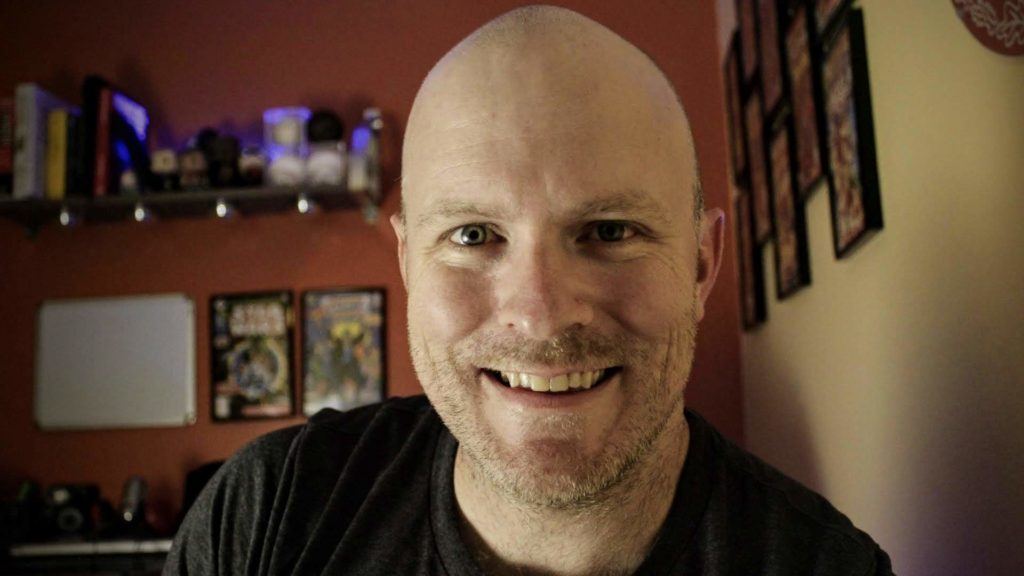By Doug Collins
Author’s note: This is the text of the talk of I gave today at UXCopenhagen. I hope it inspires us all to make a positive change in the world.
When I first sat down to write this talk, I had a vision in my head – a room full of hundreds of designers, brought together to help make the world a better place. And in a room full of people who already believed in the power of design to do good things in the world, what better purpose could I possibly have than giving them the tools they needed to change the world themselves.
It seemed so simple then.
Even at the beginning of the month, when I first gave this talk in Denver for my coworkers to get their feedback, I didn’t understand the magnitude of the change and struggle we were all about to endure.
All around us, our battle with COVID-19 has left its mark on humanity. All around us, people are fighting for their lives or their livelihoods. Hospitals around the world are overwhelmed. Hundreds of thousands people have been infected; tens of thousands have died. What’s more, millions of people have lost their jobs, and many of those who haven’t are being forced to choose between their paychecks and their health.
And things are going to get worse before they get better. The odds are great that most people in this room will suffer in some way from the virus that seems to be all around us, controlling nearly every aspect of our lives right now.
Most of you are watching this from home today, driven away from your work and your colleagues by fear of a deadly threat that humanity doesn’t fully understand.
And as I prepared to record this talk, I began to wonder if talking about changing the world for better was even the right priority now.
But in moments like we find ourselves in right now, it’s easy to give into the darkness. When we feel we have no control, we give up our power.
And yet here I am. talking to you today about changing the world. Seems heavy, right? Difficult, right? Impossible, right? And yet here I am. Here we are.
Difficult times have come, but they have not come to stay. They have come to pass. It’s important to know this. Even though we’re fighting for our lives and the lives of everyone we love right now, understanding that you have the power to make the world a better and brighter place in even the darkest of times is necessary.
Because of that darkness, now, more than ever, we have more opportunity – and more need – to bring a brighter light to the world than many generations ever will.
And sometime in the next 20 minutes, someone listening to these words is going to come up with an idea to change the world.
And if that sounds improbable, or indeed impossible, let’s take a step back from our lofty ambitions and talk about what makes this group of people, listening today, perfectly capable of changing the world.
Let’s talk about what it takes to change the world – and about some of the designers who have.
And let’s talk about a mantra to guide us and focus us.
It all comes down to three things: your skills, your desire, and your daring.
I can. I will. I must. That is our mantra today.
I can. I will. I must.
First and foremost, you need to recognize the skills that you have. So many of you here today are in the design sphere, where giving and getting feedback is a staple of our day-to-day lives. We’re open and honest with our colleagues about their work, and expect them to be the same with us. However, we’re constantly selling ourselves short – not wanting to believe in the true power that we hold within. That’s why things like Imposter Syndrome, anxiety, and depression run as such common themes in the lives of so many in the UX and design communities.
So I want everyone here to take a second, stop, and ask yourself – “What am I really good at?” It doesn’t have to be work related. There’s no limits here. I want to know what you’re really good at.
This is your “can” in “I can, I will, I must.” What can you do?
If you need a minute to think about it, let me tell you a story about someone struggling to find their can.
Kim White was a design engineer who spent much of his time in junior school in Zimbabwe dreaming up crazy product ideas. Growing up Zimbabwe, Kim saw his peers around him struggling with their personal and professional identities in one of the world’s harshest economies.
For those unaware, Zimbabwe experienced hyper-inflation in 2008 due to national debt, a flagging economy, and rampant government corruption. At one point inflation was pegged 79,600,000,000% annually (which meant that every day their money was worth only about half as much as it had been the day previously – an exponential decline that left the Zimbabwean dollar utterly worthless.
While a nifty side effect is that you can become a trillionaire by buying a 10 Trillion Zimbabwean note for about $9.75 (I checked it on e-bay today), for the people of Zimbabwe it was no laughing matter.
Kim wanted to help restore not only economic prosperity to his countrymen, but he wanted to give them some measure of hope for the future.
He wanted to help – but what could he do? Was he even capable of doing anything with any sort of lasting impact?
Kim’s personal journey took him down the path of earning multiple degrees in engineering and product design from universities in England and Colorado. And when he returned to the professional world, armed with his new knowledge and skills, he began to believe in his ability to change the world.
And it was then that Kim pulled back one of his crazy ideas from his childhood, and realized that now was the time to make it a reality.
That’s when Kim started Zimbowties – artisan bowties made local craftspeople.
Their web site, Zimbowties.com, boasts that “Each of our eye-catching, one-of-a-kind pieces are handmade from upcycled fabric offcuts in Mutare, a small city in the Eastern Highlands of Zimbabwe, the beautiful country at the heart of Southern Africa.
“We send our art out, into the world, to start conversations. Conversations about the positive impact of creativity and inspiration.
“We work with 8 artisans in Zimbabwe who create all of our products and packaging by hand with upcycled and recycled materials. Marjorie, who’s featured in this video, is one of the tailors we work with. Selling our pieces around the world allows us to pay our tailors 5 times the minimum wage in Zimbabwe.
“By getting creative and repurposing offcuts of fabric rather than using virgin material to make all of our products we’ve saved over 81,000 litres of water (21,000 gallons). That’s enough water for more than two and a half years of daily showers!
“We’ve awarded 33 merit-based, creativity awards to talented youngsters in Zimbabwe who we hope to inspire to develop their creative skills and thinking to become the next generation of problem-solvers, change-makers and innovators in Zimbabwe.
So how did Kim make this jump from engineer to purveyour of bowties and hope for his community? By reaching back into his memory for a spark, and finding his “I can.”
“Even though I became a design engineer who could design and make stuff I came to realise that I didn’t really understand much outside of my field of expertise. And, as a recovering perfectionist, I also realised that if I didn’t just jump into starting up something and learning as I went along, I might spend the rest of my life just being a dreamer instead of a doer.
“Once I’d decided I would start something, my motivation for creating Zimbowties in particular was to inspire fellow Zimbabweans, young and old, to think differently about their own potential and the resources available to them.
Kim is a great example of finding your “I can.” But that’s only a third of your equation. Once you accept that you have the ability to change the world, you have to come to terms with the fact that not only can you change the world, but that you will change the world.
I can. I will. I must.
And as you did a moment ago, thinking about what you’re good at, I want you to stop for a moment and ask yourself where does you will come from. What’s driving you? What inspires you? What is your purpose?
Long before I ever even dreamed that being a designer or heard of this crazy thing called “User Experience,” I had one goal in mind: to be a writer.
Now there were a million reasons why this was a bad idea. I had despised the assigned reading that was such a staple of my high school experience that I just flat-out neglected to do it. For some reason, classics like Willa Cather’s Death Comes to the Archbishop, with its themes of the nature of ministry and service to God in mid-18th century New Mexico, just didn’t speak to me.
On the rare occasion when I did connect with a piece, like I did with Shakespeare’s Othello, something always seemed to get in the way, like it did when Norah Fischer, who had seen the movie O, spoiled the ending by asking if Othello murders Desdemona in this one, too.
It may be almost 20 years later, but no, Norah, I still haven’t forgiven you for that one.
But putting aside my neglect of the classics of the English language, I had fallen to the fallacy buying all the right tools and waiting for inspiration.
I had some very nice leather-bound notebooks that I was sure would someday contain some great work of mine. I had pens that glided and practically sang as they danced across the page so smoothly that I felt like I was writing on ice.
I was smart, or at least I was convinced I was. I was capable, too. I had the time, and the will.
I just didn’t have anything worth writing.
Multiple times a week I’d go to some happy place – a quiet, comfy and cozy coffee shop, the park by where I grew up as a kid, or some other suitably prosaic site – and sit and wait for the inspiration for my work to come to me.
And I’m proud to announce this year I am the author of exactly zero published books. Despite me possessing all the skills and talent necessary to write something – even if it was something that was so bad that it might only ever be seen or read by even a just a couple of people – I neve wrote a single book.
This, in essence, was the reason for the change in my talk. Inspiration is not enough to effect change. You cannot wait for your work to come to you. Having the talent, the skills, and the desire to be successful is no guarantee of actual success.
And when we’re talking about changing the world, we come back to that question of scope. What makes a change a success?
I ask myself the same question about what would have made my book – the one that I’ve never written – a success. To expect the first thing I ever wrote to be a bestseller would have been crazy. To even get a book published by a major publishing house these days is hard. So what makes a success? If I sold 1,000 copies? 100 copies? If I gave it away for free, and it moved just a single person, would it have been worth it?
It’s the same question of scope that we have when we talk about changing the world. To think that your first project is going to change the entire world is probably a little unreasonable. Could it happen? Absolutely. Should you shoot for the moon? Definitely.
But don’t just make peace with the fact that your project may not have the wide-reaching implications that you’d like for it to have, make peace with the fact that it doesn’t have to.
I’m willing to bet that if you look deep down in your heart and you find what you know is already there – that you have the ability to make even just one small part of your community a little bit better, that your effort will have been worth it. I don’t believe you’d be here today if some part of you didn’t already have that belief – and once you vocalize and accept that belief, you have accepted your “I will.”
I can. I will. I must.
If you understand your potential, and you understand your drive, the last tool you need is to understand your why, because understanding your why is what brings you power.
Why is it up to us to change the world? Why is it left to us to do that hard work to make a light in the dark? What do you think?
A few days ago, my manager Mike Vaughn (who’s listening in today) and I were talking about why I do everything I do for the UX Community.
I’m sure some of you here are aware that I do more than just show up and give talks (okay, this is my first talk ever, so I barely even do that, but hey.) I do a lot for the UX World, from hosting this NUXer meetup we’re at tonight, to writing articles for UX websites, to running my own UX website, and recording my own UX podcast and YouTube videos. I ask questions of my followers on Twitter everyday (check out the #uxtalk hashtag to follow along) and try to spark and engage conversations.
It’s a lot of work – and work that I by no means have to do. So why do I do it?
I gave him some off-the-cuff answers at the time – and Mike, I’m sorry, but I’m not sure those answers were totally accurate. To be honest, I wasn’t really sure.
My answer didn’t come until just a few days ago, standing next to my mom and my father-in-law. I had recently helped out on a project for his website, and being the gracious man he is, he was singing my praises.
My mom, knowing the work I’ve put in to get to where I am, mentioned how I had a lot to be proud of.
She used a term that’s a bit of a sensitive one with me – she called me “self-made.”
I’ve never liked that term, though I can understand why she used it. I’m very fortunate to be speaking here today, not just in the sense of being fortunate to be preparing to travel to give this talk in an amazing city, sharing the stage with a host of amazing colleagues that I’ve looked up to quite for some time. I’m fortunate to be here in the sense that my being here today, talking to all of you, was an improbability that, a decade ago, I could never have imagined.
Let me take you back to 2009. It was the year Michael Jackson died. A Nigerian man attempted to blow up an airliner with underpants explosives. Unemployment was at its highest point in decades (8.1% in the US).
So you could say that things were looking up.
Okay, maybe not looking up – but changing. That’s one thing for sure. In 2009, everything was changing for so many people.
And for me, 2009 is the year that changed my life.
I started working at Nordstrom Bank, the credit division of Nordstrom, a high-end department store, that year. I wasn’t working there as a designer. Or as a product manager. Or even as a developer. I was there as a call center representative, taking phone calls from customers calling in about their credit cards.
This wasn’t where I wanted to be. I had gone to school for journalism, had an internship with the Denver Broncos (the American Football team in my hometown) and even worked for a time as a sports reporter. The time I had spent in college taught me some design basics, and I taught myself how to code a website. I had skills and dreams and hopes.
But 2009 had kicked my ass.
I had started that year engaged to a woman who was working towards becoming a doctor. I had dropped out of college just 40 hours short of my degree to support her while she worked on her degrees. And everything felt stable, right up until the moment she left me for someone else.
And that’s when my world came crashing down.
The economy tanked. I was fired from my job as an Operations Manager for an electronics store – a job I had only taken to help make my now ex-fiance’s dream a reality.
Newspapers everywhere were dying. The oldest and largest newspaper in Denver shuttered permanently, flooding the market with talent that had degrees, experience, and that was willing to work at any price.
I couldn’t compete with that in the market, and so after a few months of unemployment here I was, taking phone calls and wondering what would become of my life.
Because the truth is that sitting on the phones, living in a tiny apartment, and just barely surviving wasn’t me. It may have been where I was, but it wasn’t me. I knew I had more to offer the world, more to contribute, more to do.
And it was at this time when the biggest truth of my life hit me – and it was this: changing your life is hard.
I took between 100 and 200 calls for Nordstrom every day, and did my best to help people. But the tools we were given to do our job were terrible.
Credit is a highly-regulated industry in the US. There were things you could do, and things you couldn’t do; things you had to say and things you absolutely couldn’t say.
And the way were supposed to devine all of this was by using a single website, built in FrontPage 2004, that had no search functionality. Everything was organized by topic, alphabetically – but if you didn’t know which topic something fell under, you were in a world of hurt trying to find it.
And that horrible tool is what sparked me to change. In the five to thirty seconds between calls, I used Notepad and Internet Explorer to start to code a better site, from scratch, by hand.
At first it was just a list of links of pages in our online manual that I visited most often, and as that proved to be useful, I started to add more. Then I added methods for keeping track of policy updates. And I added and tested more and more functionality with my colleagues.
I looked up coding articles that told me how to do what I wanted to do with my site. I read design pieces that talked about how to make things easy and intuitive.
It was right around this time that I learned with “User Experience” was, and I remember it as an epiphany, sitting in a McDonald’s booth off the 5 in Costa Mesa, when I read those words and read the description of just what UX Design was about – making the world a better place through better apps, sites, and experiences.
And from there, I was hooked. I dove in and read more and more.
And you might think it’s funny that I remember this particular epiphany taking place at a booth of a McDonalds in Costa Mesa. In truth, that’s one of the more comfortable places I worked from at the time.
While all of this was going on, I was living out of my car, having foolishly chased a girl to California from Colorado without a plan on how to get a permanent address there. Most nights I fell asleep inside my 1998 Ford Escort at a small rest stop off the 5 freeway just south of Camp Pendleton.
Incidentally, I’m recording this talk as that girl I chased to California and our 2-year old son are sleeping peacefully two floors above me – so you can see where this story is going.
I was eventually able to pitch my project to the CEO after years of working on it as a pet project – and being told in no uncertain terms to stop it. It was part of a management training program that sought to identify talent in the call center and promote them into more appropriate roles in the business.
Applicants had to put together a business case for a project to help the company, and pitch the idea to the C-level management team. I remember putting together the business case that proved we could save an average of 34 seconds per call, which equated to millions of dollars a year in saved productivity, and thinking this was my chance.
As I finished the pitch, I remember the CEO looking around and asking “Why aren’t we already doing this?”
At that moment, my life changed. I was accepted into the management training program and eventually promoted to software developer. From there I weaved my way through Nordstrom, HSG/Four Winds Interactive, Trust Company of America, and E*TRADE before coming to rest where I am today, as a Senior UX Researcher for CACI.
Along the way I’ve read so much and learned so much – but I did not teach myself. I learned from Nick Fink, Joe Natoli, Nick Babich, Don Norman, and many, many other UX pros who burned the candle at both ends to make content that helped me grow professionally.
And this, at its core, is why I object to the term of being a self-made person. No one is self-made. Arnold Schwarzennager has a great speech about this, and I want to share just a little excerpt from it perfectly sums up my “I must” exists. It runs like this:
“I came over here with absolutely nothing. I had $20 in the pocket and some sweaty clothes in a gym bag. But let me tell you, I had this one little apartment and on Thanksgiving, the bodybuilders from Gold’s Gym came to my apartment and they brought me pillows, dishes, silverware, all of the things I didn’t have.
“None of us can make it alone. None of us… I always tell people that you can call me anything that you want, but don’t ever, ever call me a self-made man. It gives the wrong impression, that we can do it alone. None of us can.
“The whole concept of the self-made man or woman is a myth. I would have never made it in my life without the help. So this is why I don’t beileve in a self-made man. Why I want you to understand that is, because as soon as you understand that you are here because of a lot of help, then you also understand that now it’s time to help others. That’s what this is all about.”
And while Arnold was giving thanks for his pillows and dishes and silverware, I give thanks for the articles, blogs, and support that have gotten me to where I am today.
I could not have done this alone – and for anyone with any level of success, it’s incumbent you to give back what you’ve received. To stay humble and kind, and help those coming up in the world around you.
And all around us, the world over, leaders in the design community are taking the reins of change and accepting their “I must.” Now, more than ever, we must accept that burden – and take that first step.
From pushes as serious as HZMap.live, a volunteer-run, crowd-sourced app that Hong Kong’s protesters used to coordinate their activities and attract (and avoid) police movement during their campaign to retain their guaranteed freedoms to as laid-back as the Historic Renaissance Ride, an annual bike ride to celebrate and preserve the artistic heritage of Newark New Jersey, designers are embracing their power to change the world.
At 21 Pixels in Nigeria, they work, sometimes without computers or electricity, to train future designers and engineers.
At Design Club in London, they’re using their skills as designers to setup design training for children around the world, looking to foster empathy, collaboration, and problem solving.
In South Africa, Trevor Swart and his team worked to develop a gamified water-saving app, complete with leaderboard, to help save the city from running out of water.
Paul Bryan runs designforthehomeless.org to come up with design solutions to the problems that homeless populations face every day.
Matthew Coats runs MyRXSidekick.com to help underprivileged people in the US find affordable access to medication.
Are they changing the world for everyone? Not necessarily. But they are changing the world for someone – and that is always enough.
And so we end where we begin – with our mantra.
I can. I will. I must.
What can you do? What will you do? What must you do?
Three questions. Three answers to change the world.
How will you change the world?




